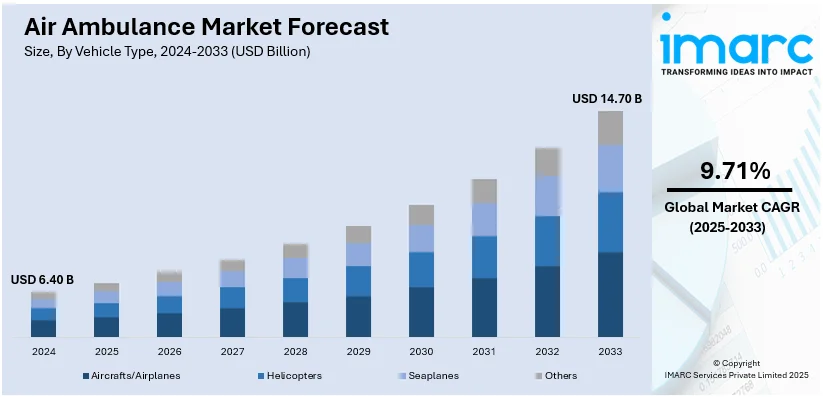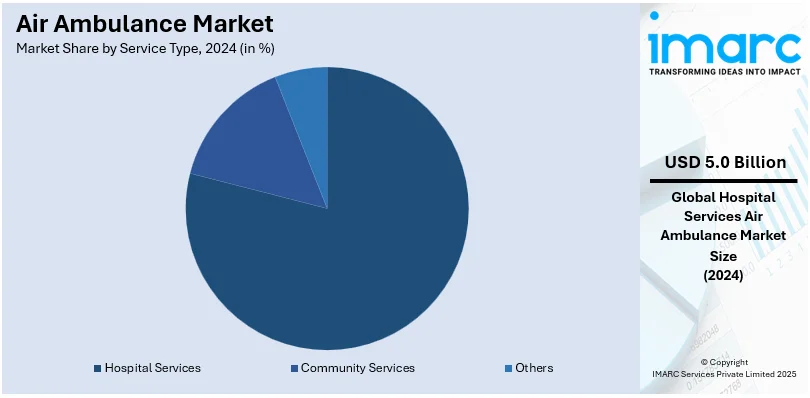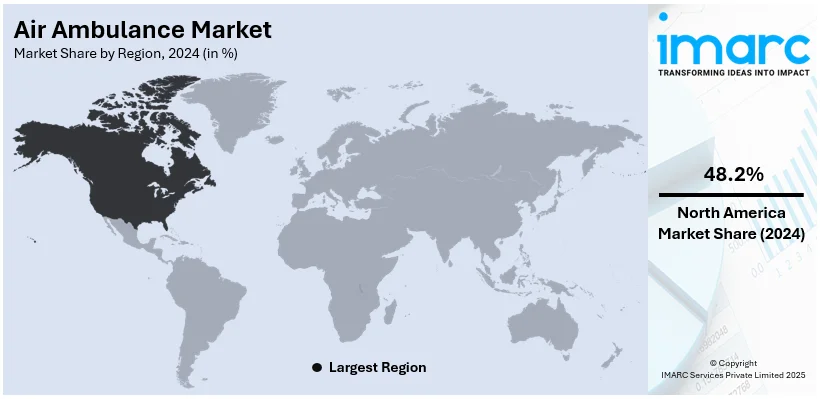
Air Ambulance Market Size, Share, Trends and Forecast by Vehicle Type, Service Type, Application, and Region, 2025-2033
Air Ambulance Market Size and Share:
The global air ambulance market size was valued at USD 6.40 Billion in 2024. Looking forward, IMARC Group estimates the market to reach USD 14.70 Billion by 2033, exhibiting a CAGR of 9.71% from 2025-2033. North America currently dominates the market, holding a market share of over 48.2% in 2024. The rising demand for emergency medical services, significant developments in air medical transport technology, and rising healthcare expenditure are responsible for the exponential growth of the market across the region.
|
Report Attribute
|
Key Statistics
|
|---|---|
|
Base Year
|
2024
|
|
Forecast Years
|
2025-2033
|
|
Historical Years
|
2019-2024
|
|
Market Size in 2024
|
USD 6.40 Billion |
|
Market Forecast in 2033
|
USD 14.70 Billion |
| Market Growth Rate (2025-2033) | 9.71% |
The global market for air ambulances is thus motivated by multiple factors, some of which have to do with the increasing rate of road accidents, natural catastrophes, and medical emergency situations that compel more individuals into emergency medical services (EMS). Technological developments in the area of air medical transport-such as greater accuracy in navigating, real-time communication tools, and specialized equipment in medical matters-have greatly impacted the efficiency and reliability of such services. These factors further supplement the growth of this market-the rising prevalence of chronic diseases and growing aged population, which mostly demands on-site medical attention. Government and private investments in healthcare infrastructure, coupled with the expansion of air ambulance networks in remote areas, have been further augmenting the market.

The United States stands out as a key market disruptor due to a growing demand for swift emergency medical services, fueled by the elevated occurrence of trauma injuries, traffic accidents, and heart-related emergencies. The increasing number of elderly individuals and common chronic ailments, such as strokes and respiratory diseases, generate ongoing need for prompt medical evacuations and critical care transportation. Improvements in aviation technology and medical devices, such as advanced onboard monitoring systems and life support features, enhance the effectiveness of air ambulance services. Moreover, the incorporation of air medical services into all-encompassing insurance plans and the increasing partnership between private healthcare providers and air ambulance firms further bolster market expansion.
Air Ambulance Market Trends:
Rising demand for emergency medical services (EMS)
The growing need for EMS and increasing instances of road accidents, natural calamities, and other medical emergencies have driven the market for air ambulance worldwide. Under challenging terrains or inadequately developed infrastructure in road facilities, an air ambulance may be the only option for ferrying a patient to advanced health care. Given their time-sensitive conditions, from heart attacks, stroke to severe traumas, their time for intervention makes air ambulance integral to a present-day health delivery system. Moreover, the global rise in urbanization and population density, particularly in developing regions has led to increased traffic congestion, making traditional ambulance services less efficient in emergency scenarios. According to the World Bank Group, 600 million individuals in India are expected to reside in urban areas by the year 2036.
Technological advancements in air medical transport
Innovations in aviation and medical technology are strong drivers of the global air ambulance market. High-tech medical devices, such as ventilators and defibrillators, alongside real-time monitoring systems, enhance the quality of care during the transport process by modern air ambulances. Aircraft design also has improved as the development of lightweight and fuel-efficient helicopters as well as fixed-wing planes enables air ambulance service to have operational range and low cost. The air ambulance teams coordinate with the ground-based medical staff in real-time communication systems so that the patient receives proper and immediate care on arrival.
Increasing healthcare expenditure and insurance coverage
Rising healthcare costs globally are another significant element driving the international air ambulance market. Governments and private entities are dedicating significant resources to improve healthcare infrastructure, which involves the creation and expansion of air ambulance systems. In advanced economies, air ambulance services are progressively incorporated into insurance plans, reducing the financial strain on patients and promoting their use. In developing markets, increasing disposable incomes and broader health insurance coverage are fueling the demand for these services. Moreover, insurance companies and air ambulance services are establishing strategic alliances to simplify billing procedures and enhance service affordability.
Air Ambulance Industry Segmentation:
IMARC Group provides an analysis of the key trends in each segment of the global air ambulance market, along with forecast at the global and regional levels from 2025-2033. The market has been categorized based on vehicle type, service type, and application.
Analysis by Vehicle Type:
- Aircrafts/Airplanes
- Rotary Wing
- Fixed Wing
- Helicopters
- Seaplanes
- Others
Helicopters dominate the market holding 71.5% market share, on account of the versatility, speed, and easy access to a remote or congested area they offer. Emergency medical services, therefore, find a helicopter best suited to their operations due to the quick response and patient transportation that are most crucial in saving patients' lives. Helicopters can land on rooftops and highways, allowing them to reach the accident site or medical emergency sites inaccessible to the fixed-wing aircraft. Their ability to work in various terrains, including urban and rural areas, increases their versatility. Moreover, helicopters are generally fitted with sophisticated medical equipment and are manned by skilled professionals, which ensures that patients receive excellent care while in transit. The increasing number of trauma cases, cardiac emergencies, and the requirement for neonatal transport also increase the demand for helicopter-based air ambulance services.
Analysis by Service Type:

- Hospital Services
- Community Services
- Others
Hospital services lead the market, holding a significant share of 78.3% in 2024. Hospital services represent the largest portion of the air ambulance market based on service type, owing to the essential requirement for swift patient transfer to specialized healthcare institutions. Hospitals, especially those featuring trauma centers or intensive care units (ICUs), are prepared to manage intricate medical situations that need urgent attention. Air ambulance services are frequently utilized to move patients from accident locations, remote regions, or smaller medical facilities to hospitals equipped to offer advanced care. This is particularly relevant for life-threatening situations such as cardiac arrest, strokes, serious injuries, or complications from chronic diseases, where each minute is crucial for enhancing patient outcomes.
Analysis by Application:
- Medical Care
- Transport
- Others
The segment of medical care in the international air ambulance market reflects critical medical service provided during the movement; it is at the core of air ambulance activity. This has been driven increasingly by the necessity for advanced treatment within emergency situations-acute trauma, heart attack and stroke, as well as newborn and pediatric emergency situations. Air ambulances are also fitted with advanced medical equipment including ventilators, defibrillators, intravenous therapy, and monitoring systems to provide high-quality medical care while in transit.
The transport sector of the global air ambulance market emphasizes the swift relocation of patients between medical facilities, particularly in urgent scenarios where ground transport is not feasible. This section encompasses the transportation of patients from accident scenes, distant areas, and even offshore sites. Fixed-wing planes and helicopters are employed for patient transport, with fixed-wing aircraft generally used for long-distance transfers between hospitals, while helicopters are preferred for quick, short-range evacuations.
Regional Analysis:

- North America
- Europe
- Asia Pacific
- Middle East and Africa
- Latin America
North America dominates the market, holding 48.2% of the air ambulance market share in 2024. The country possesses the biggest portion of the worldwide air ambulance market, driven by its advanced healthcare facilities, significant demand for emergency medical services, and considerable investments in air medical transport systems. The area enjoys a robust network of air ambulance services, outfitted with advanced medical equipment and manned by expertly trained medical staff to deliver prompt care during transit. The frequent occurrence of medical emergencies such as heart attacks, strokes, and serious injuries necessitates quick medical response, which in turn boosts the demand for air ambulance services. Moreover, North America’s extensive and varied terrain, encompassing remote and rural locations, heavily depends on air ambulances to guarantee healthcare access in areas where road transport might be unfeasible.
Key Regional Takeaways:
United States Air Ambulance Market Analysis
In 2024, the United States accounts for over 90.00% of the air ambulance market in North America. The air ambulance market in the United States is fueled by several essential factors, including the rising incidence of medical emergencies that necessitate prompt action, such as cardiac arrests, strokes, and serious trauma incidents. The increasing elderly population, which is more vulnerable to chronic illnesses and crises, greatly drives the need for air medical transport. Furthermore, the extensive geographic scope of the United States, which encompasses isolated and rural regions with restricted access to sophisticated healthcare services, requires the deployment of air ambulances to deliver prompt medical assistance. Improvements in technology for aviation and medical devices onboard, such as real-time monitoring tools and portable ventilators, have significantly improved the quality and efficiency of air ambulance services. The incorporation of air ambulance services into health insurance policies has also enhanced accessibility for patients.
Europe Air Ambulance Market Analysis
The Europe air ambulance sector is propelled by the growing demand for swift medical transport, particularly in nations with extensive rural regions and difficult landscapes. The increasing incidence of chronic illnesses such as cardiovascular issues and strokes, which necessitate urgent medical care, is a major driver of demand. Moreover, Europe’s growing elderly population plays a major role in the market, since older patients frequently require emergency medical assistance and specialized treatment. Improvements in technology for aviation and medical devices have further increased the dependability and effectiveness of air ambulances, establishing them as an essential component of emergency healthcare systems.
Asia Pacific Air Ambulance Market Analysis
This growing demand for emergency medical services due to increasing cases of road accidents, natural disasters, and chronic diseases that require prompt medical care in the Asia Pacific region fuels the air ambulance market. The wide geography of this region, where most of its areas are located in inaccessible remote locations, also necessitates air ambulances to deliver health care in time. The rapidly expanding healthcare infrastructure in emerging economies, such as India and China, increases the chance of air ambulance market growth. Also, upgrading technology pertaining to aviation and medical equipment has enabled air ambulance services to become more reliable and available.
Latin America Air Ambulance Market Analysis
The growing need for emergency medical services in remote and underserved regions, where road infrastructure is often inadequate for timely patient transport, drives the Latin America air ambulance market. The challenging geographical landscape of the region, with mountainous areas, dense forests, and expansive rural territories, necessitates the use of air ambulances for efficient healthcare delivery. More individuals are experiencing accident-related road trauma, natural disaster-related casualties, and heart-related and stroke emergencies. There is also an improving economic situation combined with growing medical awareness, bringing more investment for air medical service provision from individual providers and national governments.
Middle East and Africa Air Ambulance Market Analysis
The Middle East and Africa air ambulance market will be driven by the increasing requirement for advanced emergency medical services within a region dominated by diverse, and often demanding, terrains including deserts, mountains, and remote rural areas. As specialized healthcare facilities are not as accessible in the region, medical evacuation and transport in such regions through air ambulances are sought. The increasing incidence of road accidents, chronic diseases, and medical emergencies further boosts up the demand for such healthcare institutions. Medical tourism in the Middle East, wherein high-quality medical care to the residents and foreign expatriates is considered pivotal.
Competitive Landscape:
Major participants in the air ambulance sector are engaging in multiple strategic initiatives to foster growth and improve their market standing. These encompass investments in growing the fleet and implementing cutting-edge aircraft technologies to enhance efficiency and safety. Businesses are outfitting air ambulances with cutting-edge medical equipment such as portable ventilators, cardiac monitors, and defibrillators to ensure exceptional care during transit. Alliances and collaborations with hospitals, insurance providers, and government organizations are being established to enhance operations and broaden service access, especially in remote and underprivileged areas. Furthermore, participants are emphasizing digital transformation, utilizing telemedicine and AI-powered tools to enhance flight paths, track patient vitals remotely, and boost response times.
The report provides a comprehensive analysis of the competitive landscape in the air ambulance market with detailed profiles of all major companies, including:
- PHI Air Medical
- Air Ambulance Specialists
- Babcock Scandinavian AirAmbulance
- Express Air Medical Transport
- Lifeguard Air Ambulance
- Native American Air Ambulance
- Metro Aviation Inc.
- The Royal Flying Doctor Service
- REVA Air Ambulance
- Yorkshire Air Ambulance
- EAA
- Capital Air Ambulance
- AirMed International
Latest News and Developments:
- December 2024: PHI Air Medical has established a new air medical base in Red Bluff, providing advanced trauma care and transport services for critically ill or injured patients. The Red Bluff aircraft is integrated into the 911 system and equipped with whole blood on board, offering support for high-risk maternity patients, pediatrics, and neonatal transport.
- October 2024: Prime Minister Modi launched India's first helicopter ambulance service at Rishikesh AIIMS to enable rapid transportation of critical patients within the crucial 'golden hour' window, boosting healthcare accessibility. The helicopter ambulance service aims to strengthen and modernize Uttarakhand's healthcare services, particularly in remote areas with difficult terrain, providing lifesaving assistance during crises.
Air Ambulance Market Report Scope:
| Report Features | Details |
|---|---|
| Base Year of the Analysis | 2024 |
| Historical Period | 2019-2024 |
| Forecast Period | 2025-2033 |
| Units | Billion USD |
| Scope of the Report |
Exploration of Historical Trends and Market Outlook, Industry Catalysts and Challenges, Segment-Wise Historical and Future Market Assessment:
|
| Vehicle Types Covered | Aircrafts/Airplanes (Rotary Wing, Fixed Wing), Helicopters, Seaplanes, Others |
| Service Types Covered | Hospital Services, Community Services, Others |
| Applications Covered | Medical Care, Transport, Others |
| Regions Covered | Asia Pacific, Europe, North America, Latin America, Middle East and Africa |
| Companies Covered | PHI Air Medical, Air Ambulance Specialists, Babcock Scandinavian AirAmbulance, Express Air Medical Transport, Lifeguard Air Ambulance, Native American Air Ambulance, Metro Aviation Inc., The Royal Flying Doctor Service, REVA Air Ambulance, Yorkshire Air Ambulance, EAA, Capital Air Ambulance, AirMed International, etc. |
| Customization Scope | 10% Free Customization |
| Post-Sale Analyst Support | 10-12 Weeks |
| Delivery Format | PDF and Excel through Email (We can also provide the editable version of the report in PPT/Word format on special request) |
Key Benefits for Stakeholders:
- IMARC’s report offers a comprehensive quantitative analysis of various market segments, historical and current market trends, market forecasts, and dynamics of the air ambulance market from 2019-2033.
- The research study provides the latest information on the market drivers, challenges, and opportunities in the global air ambulance market.
- The study maps the leading, as well as the fastest-growing, regional markets.
- Porter's Five Forces analysis assists stakeholders in assessing the impact of new entrants, competitive rivalry, supplier power, buyer power, and the threat of substitution. It helps stakeholders to analyze the level of competition within the air ambulance industry and its attractiveness.
- Competitive landscape allows stakeholders to understand their competitive environment and provides an insight into the current positions of key players in the market.
Key Questions Answered in This Report
The global air ambulance market was valued at USD 6.40 Billion in 2024.
IMARC estimates the global air ambulance market to exhibit a CAGR of 9.71% during 2025-2033.
The global air ambulance market is driven by rising demand for emergency medical services, advancements in air medical transport technology, increasing prevalence of chronic diseases, and growing healthcare expenditure.
North America currently dominates the global market due to the increasing prevalence of cardiac arrests, strokes, and serious trauma incidents.
Some of the major players in the global air ambulance market include PHI Air Medical, Air Ambulance Specialists, Babcock Scandinavian AirAmbulance, Express Air Medical Transport, Lifeguard Air Ambulance, Native American Air Ambulance, Metro Aviation Inc., The Royal Flying Doctor Service, REVA Air Ambulance, Yorkshire Air Ambulance, EAA, Capital Air Ambulance, AirMed International, etc.
Need more help?
- Speak to our experienced analysts for insights on the current market scenarios.
- Include additional segments and countries to customize the report as per your requirement.
- Gain an unparalleled competitive advantage in your domain by understanding how to utilize the report and positively impacting your operations and revenue.
- For further assistance, please connect with our analysts.
 Inquire Before Buying
Inquire Before Buying
 Speak to an Analyst
Speak to an Analyst
 Request Brochure
Request Brochure
 Request Customization
Request Customization




.webp)




.webp)












